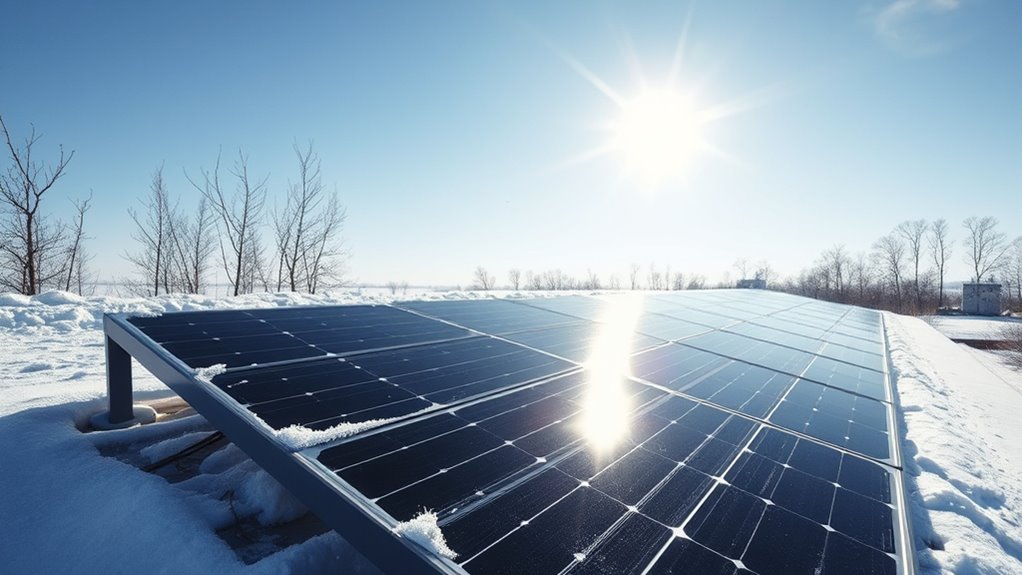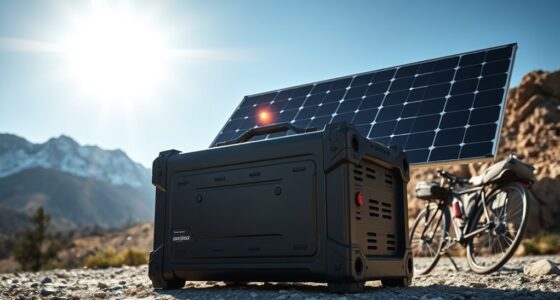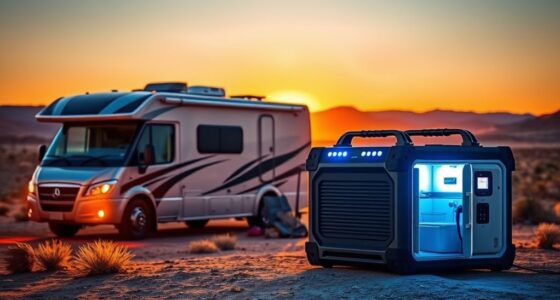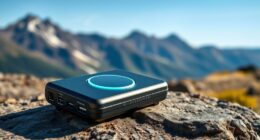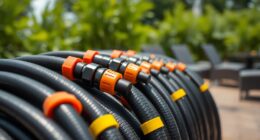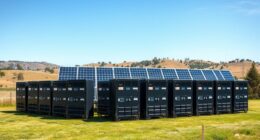To maximize solar input during winter, regularly clear snow, ice, and debris from your panels to guarantee they absorb as much sunlight as possible. Adjust the tilt angle to a steeper position aligned with the sun’s lower path, and make sure tracking systems are working correctly. Keep an eye on weather forecasts to prepare for cloudy days, and store backup power sources ready. Proper maintenance and positioning can make a big difference—continue exploring for more expert tips.
Key Takeaways
- Regularly clear snow, ice, and debris from panels to prevent efficiency loss and ensure maximum sunlight absorption.
- Adjust panel tilt to a steeper winter angle aligned with the sun’s lower position for optimal solar input.
- Monitor weather forecasts and use backup power sources during cloudy or stormy days to maintain energy supply.
- Handle frost and ice gently with soft tools, and promptly remove buildup to keep panels functioning efficiently.
- Insulate batteries and store components in sheltered areas to prevent capacity loss and ensure reliable charging during cold months.
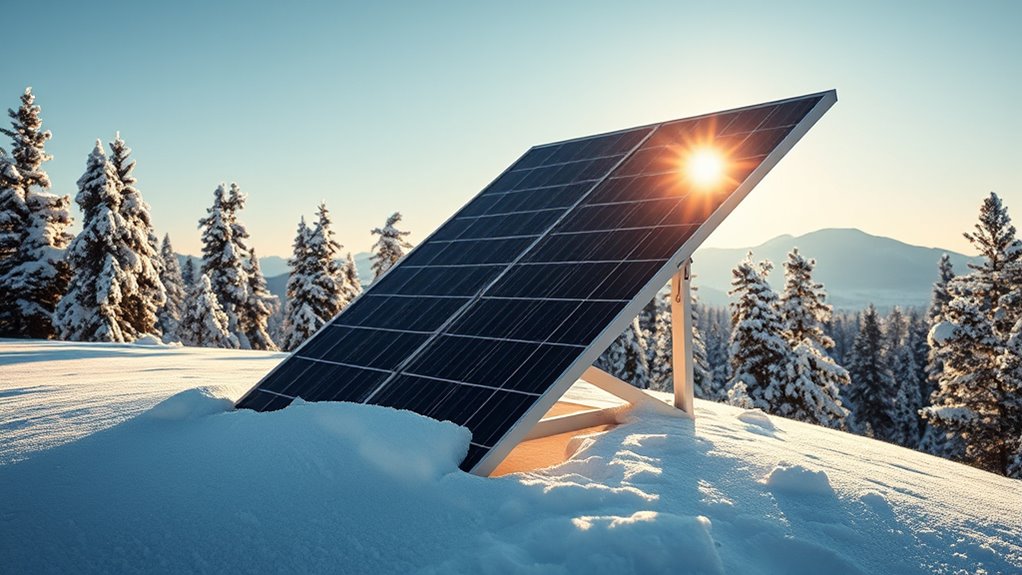
Winter’s shorter days and lower sun angles can make solar charging seem challenging, but with the right strategies, you can still keep your devices powered. The key lies in understanding how to optimize your solar setup during the colder months. Regular solar panel maintenance becomes essential now; clear snow, ice, and debris from your panels to guarantee maximum sunlight absorption. Even a light layer of snow can markedly reduce your panels’ efficiency, so check them frequently and brush off any buildup to maintain peak performance. Keep in mind that ice can cause damage if it’s heavy or persistent, so handle cleaning carefully to avoid cracking or scratching the surface.
Regularly clear snow and ice from panels to maximize winter solar efficiency.
To maximize winter power, you should also consider adjusting your position to capture the most sunlight possible. As the sun sits lower on the horizon, angling your panels more steeply can improve energy collection. Use a tilt that aligns with the sun’s position during winter months—typically, a steeper angle than in summer. If your panels are mounted on a tracking system, ensure it’s functioning correctly and adjusted for the season. This small change can make a notable difference in how much sunlight your panels receive each day.
Another effective tip for winter power optimization involves monitoring the weather forecast. Overcast days or snowstorms can drastically reduce solar input, so plan your energy consumption accordingly. If you’re relying on solar power for critical devices, consider having backup options like portable power banks or generators on hand for cloudy periods. During particularly cold days, keep your panels free of frost and ice, but avoid using harsh chemicals or abrasives that could damage the surface. Gentle brushing with a soft tool often does the trick. Additionally, understanding how kidney stone prevention may relate to certain fluids can help you optimize your hydration strategies during winter.
Lastly, think about your overall system setup. Making sure your batteries are well-insulated and kept warm can prevent capacity loss due to cold temperatures. Store your solar components in a sheltered, frost-free environment when not in use, and check wiring for any signs of wear or damage caused by freezing conditions. Combining diligent solar panel maintenance with strategic positioning and weather awareness will help you squeeze the most power out of your system during winter. By staying proactive, you’ll keep your devices charged and ready, no matter how low the winter sun dips.
Frequently Asked Questions
How Does Snow Accumulation Affect Solar Panel Efficiency?
Snow accumulation can considerably diminish your solar panel efficiency by blocking sunlight. To combat this, you should adjust your panel tilt to help snow slide off more easily. Regular snow removal techniques, like gently sweeping with a soft brush, prevent buildup without damaging the panels. Keeping your panels clear ensures maximum sunlight absorption, even during winter. Proper maintenance and strategic tilt adjustments are key to maintaining ideal energy input during snowy months.
Can I Use Portable Solar Chargers in Winter?
Yes, you can use portable solar chargers in winter. Just make certain your device has good solar panel durability to withstand cold and snow. Check that the portable charger compatibility matches your gadgets, especially since colder temperatures can affect performance. Keep the panels clear of snow and ice, and position them where they get direct sunlight. With proper care, your portable solar charger will work efficiently even during winter months.
What Temperature Ranges Optimize Solar Panel Performance?
Did you know that solar panel materials perform best between 15°C and 25°C? Temperature effects show that high heat can reduce efficiency, while cold temperatures can actually boost performance. For ideal solar panel performance, aim for this temperature range, as it minimizes efficiency loss. In winter, colder temperatures generally benefit solar input, but avoid extreme cold that could damage panels. Keep your panels shaded and clean for the best results.
Do Winter UV Levels Impact Solar Energy Production?
Winter UV levels do impact your solar energy production because UV intensity influences sunlight penetration. When UV levels are lower, sunlight doesn’t penetrate as effectively, reducing your panels’ efficiency. Cold weather can help, but if UV levels drop considerably, it lessens the energy your panels generate. To maximize output, guarantee your panels are clean and positioned for ideal sunlight, especially during periods of decreased UV intensity.
How Often Should I Clean Snow off My Panels?
Think of your panels as winter warriors battling snow. You should remove snow as soon as it accumulates enough to block sunlight, usually after a fresh snowfall. Regular panel maintenance and gentle snow removal techniques, like using a soft brush or squeegee, help maintain peak energy flow. Don’t let snow sit too long; the longer it stays, the more energy you lose. Keep your panels clear for maximum winter power!
Conclusion
So, embrace the winter gloom—your solar panels might not be thrilled, but you’ll still get some juice if you play it smart. Who knew that frozen mornings and shorter days could actually teach you patience and resilience? Keep those panels clean, angle them just right, and maybe—just maybe—you’ll outsmart the season’s best efforts to leave your devices in the dark. After all, winter charging isn’t about perfection; it’s about making do with a little solar sarcasm.
